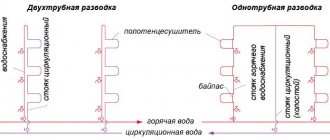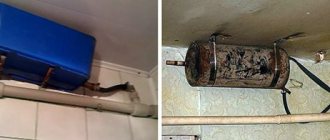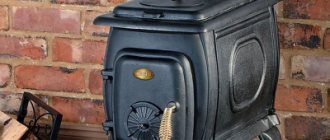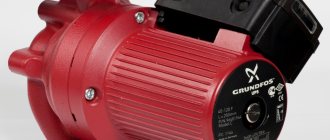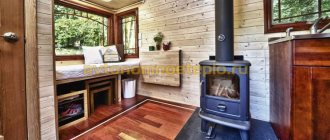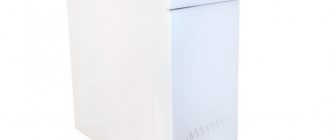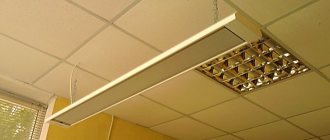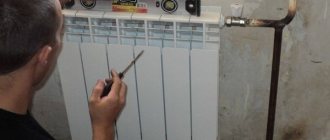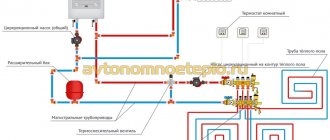A heated towel rail in the bathroom is a simple and at the same time functional device, the purpose of which is not limited to drying wet towels. There are at least three more reasons to install such a plumbing fixture in a house or apartment. If connected correctly, it allows you to improve the microclimate in the bathroom; in addition, it can be used as an additional heating radiator during the cold season or a place for drying small items after washing. If you have not yet selected a heated towel rail that is suitable in design and construction, you can do so here.
Installing or replacing a heated towel rail in a bathroom is not an overly complicated task: if you have basic DIY plumbing skills, you can do the connection yourself. In this article, we have collected important installation tips, as well as photo illustrations with basic diagrams that will allow you to install a heated towel rail or monitor the work of hired craftsmen.
Principle of operation
First of all, let’s figure out what modern heated towel rails are. As a rule, we are talking about a pipe of a zigzag design, which is installed on the wall of the bathroom and connected to the hot water supply circuit. In older designs, the operation of which was based on the continuous circulation of a heated coolant fluid, the so-called “loop” principle was used. At the same time, the residents of the multi-storey building were provided with hot water, which was supplied through pipes from the upper floor to the lower ones, and when the water flow reversed from the bottom up, heat was collected for the heated towel rails.
The main technological condition for the correct connection of the heated towel rail was that its loop-shaped pipe corresponded in diameter to the pipes of the riser itself. Only in this way was the correct circulation of the coolant in the hot water supply circuit ensured without excessive hydraulic resistance.
Installation of a water-type device
- Taps are installed on the supply line to cut off the water supply in case of an emergency. To ensure that replacing models in the future is not difficult, the taps are mounted with detachable connections. This way it will be possible to eliminate minor damage without draining the riser.
- Before attaching the heated towel rail to the wall, pipes from the riser are laid to the installation site.
- The device is assembled according to the manufacturer's instructions and mounted on the wall.
Connection algorithm:
- A bypass is installed using pipes and tees. You will need: 2 valves at the connection points to the dryer, 1 valve - shuts off the water supply at the bypass.
- The dryer is fixed with brackets on the wall.
- The fittings connect the bypass with valves to the device.
- All connections are made. The taps are opened to allow water to enter the device. The pressure is kept weak to avoid water hammer.
Types of heated towel rails
Nowadays, instead of outdated and not particularly aesthetically pleasing coils of the Soviet period, modern models of heated towel rails are increasingly being installed in bathrooms, which can be divided into three main groups.
- Water appliances connected to the pipes of the hot water supply circuit.
- Electric models operating from a general power supply.
- Combined heated towel rails, the main feature of which is the ability to operate both from the hot water supply circuit and from the mains (in the event of a temporary shutdown of hot water in the house).
From a technological point of view, connecting a water heated towel rail is considered the most difficult: installing such a plumbing fixture without the proper experience is quite difficult. At the same time, errors in the connection often lead to the fact that the bathroom remains cold and damp, and the coil pipe itself warms up unevenly or does not heat up at all. That is why connecting water models should be trusted exclusively to professionals who have practical experience working with such plumbing equipment.
An electric heated towel rail is a device that requires only free access to the power supply to operate. Its connection is a standard installation of a household electrical appliance and usually does not cause difficulties. As for combined models, they are usually installed in the bathroom if there is periodically no hot water in the house, and the rules for connecting such heated towel rails are generally similar to the rules for installing water coils. Let us immediately note that the article will focus on the nuances and features of installing and connecting water-type devices.
Installation features of the combined model
The design combines water and electrical sections, so the connection includes algorithms for working with two types.
Installation rules:
- First, water towel dryers are connected to a common riser using the direct, corner or bottom method.
- They work with electricity after checking that the water part is connected correctly.
- Select the optimal location with ease of connection to the riser, electrical outlets, and take into account the ease of use of the dryer.
- The parameters of sockets and machines are selected according to standards similar to those that apply when connecting electric models.
On underwater collectors, close the valve, and cut an angle valve or tee under the heating element into the riser. The electric heater pipe is cut vertically into the heated towel rail through a tee. After tightening the nut with a wrench, the heating element is considered installed.
The heating system tap is opened to supply water, air bubbles are released using the Mayevsky tap, then the shut-off valves are closed. The heating element is turned on, it works until the thermostat automatically turns off. After this, the Mayevsky tap is turned off. This cannot be done before, because water expands under the influence of heat.
Connection options
Most often, water heated towel rails are connected to hot water supply (DHW) pipes. However, in private cottages and houses with individual heating, there is still a scheme in which a heated towel rail is embedded into the heating circuit. On the one hand, this installation technology can be called convenient and quite economical, however, in the warm season, when autonomous heating is not needed and is turned off, the heated towel rail in the bathroom does not work.
Another option is to connect a heated towel rail to an individual hot water system, working with an indirect heating boiler with automatic circulation. Regardless of the chosen pipe connection scheme, different installation options can be used.
Complex cases
There are a number of cases when attaching shelves to the wall requires care, some effort, or the use of more durable materials.
How to hang a glass shelf
Glass shelves are installed on brackets. The fastenings are fixed to the wall with ordinary self-tapping screws and covered with decorative overlays on top. The glass is clamped between two parts of the bracket using a compression mechanism.
On a plasterboard wall
To firmly install shelves on a gypsum plasterboard wall, it is necessary to make embedded parts from metal or wood at the installation stage. In this case, the fasteners will be screwed to a durable material and hold the structure tightly. If the wall is hollow, it is better to install the shelf using umbrella dowels.
Concrete wall
A special feature of a concrete wall is its strength, so installing a shelf will require drilling. To do this, use a hammer drill and a durable drill of a slightly smaller diameter than the dowel-nails that will be used.
Recommended connection diagrams
How to properly install a heated towel rail in the bathroom? This question can often be heard from many owners of houses and apartments who want their bathroom to be warm and dry all year round, regardless of the presence or absence of heating (individual or centralized).
As already mentioned, in the past, the standard schemes by which heated towel rails were installed in the bathroom corresponded to the scheme of the DHW circulation riser. Such a system did not in any way affect the performance of the entire network, since the diameters of the coil and the riser pipe were the same. If the bathroom is equipped according to this scheme, the hydraulic resistance in the network is minimized even when the line is extended. As long as heated coolant circulates through the system, the heated towel rail installed in the bathroom will remain warm.
The preferred scheme is one in which the heated towel rail is installed in the bathroom using a lateral or diagonal pipe connection. Such a scheme can be considered universal and works successfully when installing ladder-type devices that do not require narrowing the bypass. A pipe connected using this method does not require any displacement or narrowing and does not depend on the total pressure of hot water through the riser.
General rules
- When inserting into the riser, the lowest point of the heated towel rail pipe in the bathroom should be below the lowest connection pipe.
- Regardless of the layout of the bathroom, the design of the liner sections does not allow any bends. Otherwise, all existing bends will collect air and thereby prevent the natural circulation of coolant along the circuit.
- Do you want to install your heated towel rail correctly? Use pipes with a diameter of at least 20 mm (DN 20).
- Experts recommend installing pipes in the bathroom using a layer of thermal insulation material. If the heated towel rail pipe is installed in a hidden way (in a groove cut into the wall), the circuit must be thermally insulated in any case.
Advantages of lateral connection
- It is possible to modify the system if the supply pipe needs to be positioned differently.
- The efficiency of the device, as well as its performance, does not deteriorate in any direction of water supply.
At the same time, you need to understand that with a “ledged” insertion pattern (as shown in the last figure), the heated towel rail will in most cases require additional installation of an air vent.
Cranes
To control the operation of the heated towel rail, two shut-off valves with a cross-section corresponding to the main pipes are installed in front of it. The design and arrangement of these valves is not particularly important - both two-position (open/closed) ball and multi-turn products are equally suitable. However, if an air lock accidentally forms in the towel dryer, leading to a sharp decrease in the efficiency of the heating device, it will not be possible to remove it using such taps. Initially, air can be released through the nuts, but if you twist them often, the seals will quickly become unusable.
The taps usually have a threaded connection - therefore, if there are no threads on the main pipes, it must be cut or a corresponding fitting must be welded.
We install the Mayevsky tap in this way if the system often airs out
Schemes with an offset or narrowed bypass
A heated towel rail with an offset/narrowed bypass is rarely installed. As a rule, plumbers use a similar tap-in technology when it is necessary to install an offset or slightly narrowed bypass on an existing heated towel rail. In this case, the pipe is connected according to one of the standard schemes, selected by a specialist.
In practice, in most cases this technology is not used. This is explained by the fact that the coil pipe, which, in fact, is a heated towel rail, is still not an additional heating radiator, and fundamental alterations in this case will be impractical. Moreover, the installation scheme for a heated towel rail with an offset or narrowed bypass is effective only if the bathroom is equipped with an overhead hot water supply system.
Features of installation with an offset bypass
As a rule, offset is used when wiring radiators. This option is often used when plumbers are installing the heating system. At the same time, this approach is often justified when installing heated towel rails, when there is a need to preserve the old outlets on the riser, to which the old coil was connected (it was discussed at the beginning of the publication). In most cases, there is no need to replace the entire riser: the device can be installed with a bypass. The only condition in this case is the circulation of coolant water from top to bottom. If this condition is not met, the pipe acting as a heated towel rail may end up remaining cold.
Bracket device
Previously, when hardware stores did not offer such a variety, installation of radiators in the bathroom was carried out using ordinary metal hooks fixed to the wall.
However, in practice, this installation method turned out to be quite unreliable - the battery wanders around and is not fixed securely. Now special brackets are used for these purposes. They have the following device:
Remember that to hang a heated towel rail, depending on the size, weight and shape, you may need from 2 to 6 brackets. The larger and heavier the device, the more fixation points are needed to distribute it more evenly across the supports.
Bottom connection circuits
Is the bathroom equipped with a pipe with a bottom connection? In this case, you can use alternative schemes to those described above. In most cases, the pipe is installed in a similar way for hidden installation of the liner, while the bathroom (more precisely, its interior) will not be damaged. With a bottom connection, the pipe is partially masked by accessories located along the walls.
Structurally, the pipe with a bottom connection is a mini-ladder and has a very stylish and impressive appearance. At the same time, this technology is called less effective compared to structures connected laterally or diagonally.
Installation in the presence of an old tie-in with a displaced bypass
In some cases, the pipe is cut in using the bottom method, but the previous cut with a displaced bypass remains on the riser itself. Most often, apartment owners do not see much practicality in remodeling. In this case, the upper outlet is usually located high, but according to the rules it must be located below the connection point itself. A way out of this situation is possible only if two basic conditions are met.
- The scheme itself implies an upper supply of water, since if the coolant flows from below through the pipe, the so-called “locking” of the internal circuit of the system is highly likely to occur. As a result, the bathroom will remain cold.
- The upper outlet of the riser is located below the upper edge of the coil itself. Otherwise, such a device will, in principle, not be able to function.
Non-standard methods
In addition to the standard, well-known methods for installing shelves, original options using various available materials are used. These details not only allow you to conveniently and easily fix the structure, but also act as decoration.
Rings with hooks
You can hang the shelf using rings with attached hooks. The rings are attached to the wall, and the hooks are attached to the loops that are screwed into the structure in advance.
Water pipes
The method is useful in any room. Holes are made in the furniture fabric slightly larger than the diameter of the water pipe. The shelf is “put on” and fixed with a flange in the desired position. The design may consist of a single panel, or it may be an open shelving unit.
Belts
Shelves suspended on belts look original. To do this, take two leather products of the same length, fold them in half and drill them towards the wall. A shelf is inserted into the resulting loops. To prevent the canvas from moving, the straps must be screwed to the shelf with small self-tapping screws.
Ropes
Shelves hung on ropes will look great. A thin rope is used for this. 4 holes are made in the tree through which the rope is threaded. Knots are tied on both sides, thus fixing the shelf. The ends of the ropes are tied together and attached to the wall.
Hidden fasteners in books
The shelf is an old book with a metal corner screwed into it. The second part of the fastening is fixed to the wall. This shelf will hold several more books.
Basic connection errors
Very often, inexperienced plumbers make a lot of technological mistakes, trying to please a customer who is trying to aesthetically design old sections of wiring or who wants to use channels in the walls intended for other purposes for installation. Such mistakes often lead to the fact that the pipe does not heat, and the bathroom turns into not the warmest and most comfortable place in the house.
We list the main technological errors when installing heated towel rails.
- The pipe has a kind of “hump” in the upper part of the structure in the area of the upper connection. This creates a loop in which air will sooner or later accumulate. Typically, such a scheme is mistakenly used to disguise part of the pipes under the suspended ceiling.
- The lower outlet is located in the network much lower than the lowest point of the heated towel rail. At the same time, two main mechanisms mechanically enter into a kind of “confrontation”: natural and forced circulation of the coolant in the circuit.
- A particularly difficult case is a scheme in which two insertion points are located higher than the lowest edge of the heated towel rail. In such a situation, water simply cannot flow through the small circuit. Moreover, when using this erroneous scheme, a couple of bags (a kind of “traps”) are formed at once, in which the cooled coolant will be collected.
- Another problematic scheme is the location of the upper part of the supply system under the ceiling, and the lower part in the cement screed of the floor. In this case, the coil does not work for several reasons. The first is the accumulation of air masses from the ceiling, the second is the formation of the same “bag” that prevents the natural circulation of the coolant. As a result, the circulation of hot liquid is disrupted, and sooner or later the bathroom becomes a room with not the best microclimate.
Experts identify several more technological errors that are under no circumstances recommended to be made when installing a water heated towel rail in the bathroom. In particular, two omissions are considered the most glaring.
1. Unintentional narrowing of metal-plastic pipes. This phenomenon is often due to some nuances in the design of press fittings. As a result, increased hydraulic resistance occurs not only within one apartment, but also along the riser.
2. Incorrect installation of shut-off valves (taps) in front of the coil structure. On the one hand, taps installed in this way will theoretically allow you to turn off the heated towel rail if it is not needed at the moment. However, turning off any tap will simply stop the riser from working on all floors. At the same time, the coolant circulates, but its volume, devoid of mobility, sooner or later cools down. As a result, to obtain hot water, you will have to pour a fairly substantial volume of cooled liquid “into nowhere.” In the most severe cases, the so-called “airing” of the entire riser in a multi-storey building occurs in the network, which once again confirms the fact that shut-off valves cannot be installed on a heated towel rail.
Criterias of choice
When choosing, they take into account quality, design, cost of the model itself and operation.
The cost of models depends on the complexity of the connection. Cheap designs are not always of high quality, but a high price does not mean high functionality. Consider whether you need to buy additional elements to attach the heated towel rail to the wall.
When choosing, pay attention to the following factors:
- heating technology (method, type of heating element);
- volume of electricity consumed;
- is there a thermostat that operates in different modes;
- size of the structure taking into account the landing site;
- material of pipes, heating elements;
- operating conditions (humidity, room temperature, type of coolant in the pipes);
- complete set (assembly kit, fasteners, nuts, adapters for pipe outlets);
- coil diameter;
- eyeliner method.
Russian manufacturers produce models that adapt to the quality of running water in the system and pressure drops. Such models will cost less than imported ones.
The optimal combination of price and quality are stainless steel pipes. There should be no scratches or chips on the surface - such marks reduce the service life.
When choosing, pay attention to the combination of the design with the design of the room .
The water option will take up more useful space in the bathroom, but you only pay for it once during installation. The electric one is more compact, but is costly throughout the entire period of operation - it draws energy from the network even in economy mode.
How can you tell if your heated towel rail is connected incorrectly?
In the event that the household appliance was connected with gross technological errors, the drying coil will at first seem to be fully operational. At the same time, the main problem that invariably accompanies the listed installation errors is a noticeable difference in temperature (the lower part of the loop-shaped pipeline will be colder than the upper). As a result, the coolant will begin to circulate through the hot water riser, bypassing the heated towel rail, which will turn into an inoperative and useless element of bathroom decor.
